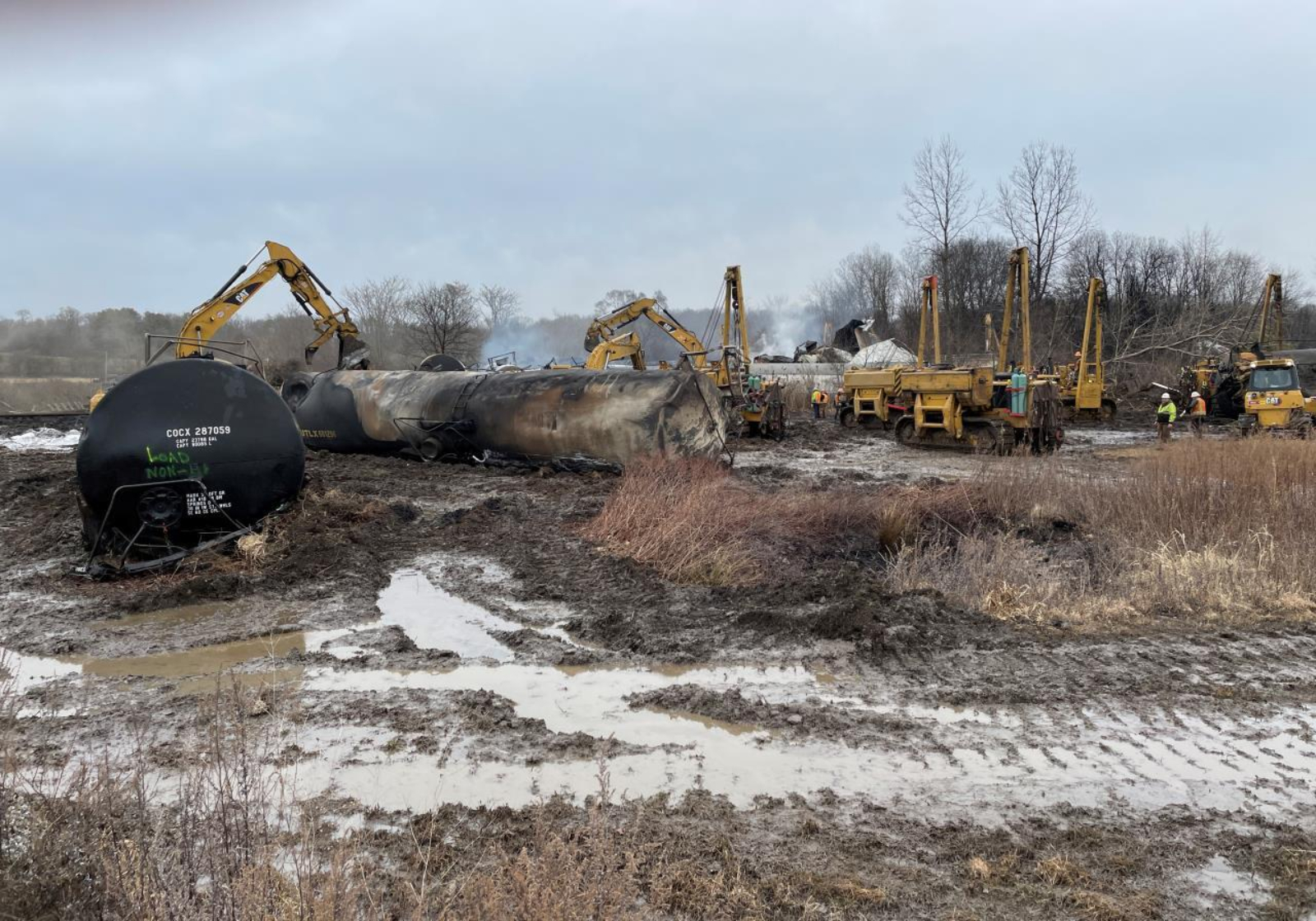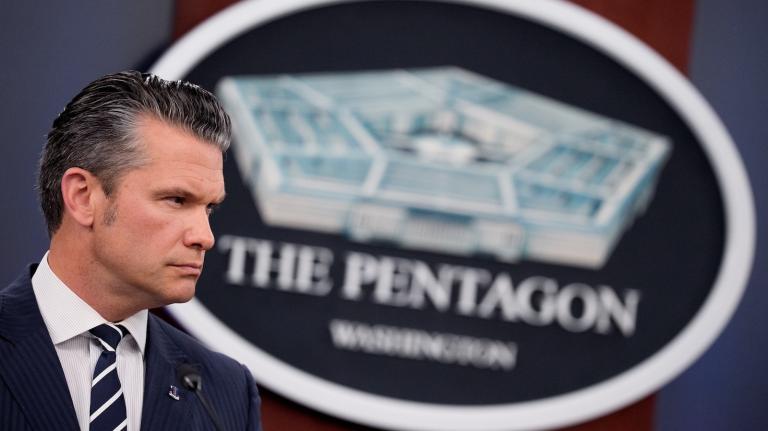When a freight train filled with volatile chemicals derailed in rural Ohio earlier this month, it set off a chain of reactions: the evacuation of a town of nearly 5,000 people; a massive black plume of smoke from a controlled burn; the death of fish in local waterways; and the necessity of monitoring the local air for pollutants.
While the disaster garners headlines, researchers and chemical spill experts told Grist it’s a situation that plays out far too often across the country.
The train that derailed around 9 p.m. on February 3 was carrying chemicals used in a variety of industries, from plastics to agriculture, each with a specific degree of hazard.
The rail industry is responsible for a large share of the movement of highly volatile chemicals and explosives across the country. But for years, it has been plagued by harsh working conditions and a lack of rigorous safety standards and transparency.
Justin Mikulka, a reporter who spent years researching the rail industry’s pitfalls and disasters and wrote the book Bomb Trains: How Industry Greed and Regulatory Failure Put the Public at Risk, said weakened regulations and a rush to reopen is to be expected.
“While the trains are still burning, they’re rebuilding the rails,” Mikulka told Grist. “It’s again an excellent example of how they put profit over public safety.”
Mikulka said, be it chemicals or crude oil, trains are getting longer, going faster, and moving through the majority of the nation’s backyard. These lines are often dubbed “bomb trains” by those in the rail industry and environmental groups.
In the last two decades, train lengths have increased by 25 percent, according to the Government Accountability Office. Currently, the Federal Railroad Administration, or FRA, does not have a limit on how long a train can be. While derailments have decreased in recent years, the severity has increased as the industry focuses on longer trains with small crews.
“The accidents that do occur, because of the longer trains, tend to be bigger accidents — more cars and more potential damage,” Steven Ditmeyer, a former head of the office of research and development at the FRA, told Vox.
Mikulka said that the Ohio derailment could have been worse.
A Northfolk Southern spokesperson told Grist that there were three operators on board the train that derailed, one conductor, one engineer, and a conductor trainee, none of whom were injured. In recent years, rail companies have lobbied for one-person crews to cut costs and rail unions have urged for two-person crews to be mandated at the federal level. Under the Trump administration, the FRA dropped the two-crew proposal, saying at the time “no regulation of train crew staffing is necessary or appropriate for railroad operations to be conducted safely.”
When crews are stretched thin, Mikulka said, accidents and derailments are just waiting to happen. He said calls from workers for increased safety measures have gone unheard. “There are so many different points in this process where we look at how we can make it safer, and the rail company says ‘Yeah, but we don’t want to pay for that.’”
At a press conference last week Ohio Governor Mike DeWine said the train that went through East Palestine was not marked as hazardous, despite the chemicals on board. He called it “absurd” and is asking Congress to investigate how hazardous materials are handled.
“We should know when we have trains carrying hazardous material that are going through the state of Ohio,” DeWine said.
The problem, however, is that freight trains are almost always carrying toxic materials, and most communities they barrel through don’t know what is onboard.
Over 250 trains derailed in the last decade, according to the Pipeline and Hazardous Materials Safety Administration, or PHMSA, a branch of the federal Department of Transportation. Nearly half of those derailments involved hazardous waste.
Rick Hind, a retired legislative director with Greenpeace with decades of chemical regulation experience, has worked firsthand with various chemical spills. He said the nation’s rail systems are the “wild west” when it comes to regulation and transparency of moving hazardous materials.
Currently, the Environmental Protection Agency, or EPA, monitors the chemicals used inside roughly 12,000 authorized chemical facilities which are estimated to impact nearly 175 million people in the country. But when those chemicals are on the rails going to and from facilities, regulations change.
PHMSA is supposed to set safety standards for trains in motion, but the agency has a notoriously brittle track record. Former California congressperson Jackie Speier called the agency “fundamentally broken” in the aftermath of a 2010 natural gas pipeline explosion in her state.
“PHMSA is not only a toothless tiger, but one that has overdosed on Quaaludes and is passed out on the job,” Speier said in a 2016 hearing. When Washington State attempted to regulate the movement of hazardous chemicals and oils within its borders in 2019, the federal government stepped in to overturn this ruling, with PHMSA legal counsel saying “a state cannot use safety as a pretext for inhibiting market growth.”
The EPA is currently reviewing its rules for Safer Communities by Chemical Accident Prevention. But, industry pressure from a large rail industry lobbying group, the Association of American Railroads, has already mounted against the federal agency’s proposals for the management of moving hazardous materials.
“We clearly need to revamp the safety rules on railroads,” Hind told Grist. “If there aren’t strong legal requirements, you can’t have strong regulations.”
Hind said workers in the rail industry face the compounding pressures of lack of paid sick and leave time, failing technology, and thin crews aboard trains that have gotten longer and longer over the years.
“Figuratively speaking, how can you check the tires on a train that is a mile and a half long?,” Hind said.
According to a report from Vice, the train that derailed in Ohio had a reputation for being difficult for rail workers, earning it the nickname “32 Nasty,” about the 32N name it was assigned. “This train is notorious for breaking knuckles or drawbars or some other malfunctions,” a rail worker told Vice.
In addition to fighting against mandated crew size, train length regulations, brake technology changes, and new standards for moving hazardous chemicals, the rail industry has not been known to adhere to a National Transportation Safety Board, NTSB, voluntary, confidential “close call” reporting system, which is an anonymous way for employees to report near-misses and unsafe incidents.
In a recent letter from Greg Regan, president of the Transportation Trades Department of the AFL-CIO union, to the head of the FRA, he said none of the seven major U.S. freight railroads voluntarily use this reporting program.
When asked if Norfolk uses this reporting system, a spokesperson told Grist that the company operates “its own reporting system of that nature with its workforce.” The spokesperson declined to comment or speculate on the cause of the derailment, citing an ongoing NTSB investigation.
Ahead of the final investigation report, Pennsylvania Governor Josh Shapiro issued a letter to Norfolk Southern, outlining concerns that the company did not immediately notify Pennsylvania emergency management and was not forthcoming with the specific chemicals and amounts on board the derailed train.
“Norfolk Southern failed to explore all potential courses of action, including some that may have kept the rail line closed longer but could have resulted in a safer overall approach for first responders, residents, and the environment,” the governor wrote.
While the people of East Palestine, Ohio, and officials await the NTSB investigation, expected to be released in the next few weeks, cleanup continues. Federal investigations could be underway as Congressmembers have expressed plans to investigate after the final investigation is released. A spokesperson for the Committee on Transportation and Infrastructure Republicans told Grist that they are currently in contact with the federal agencies involved and Norfolk Southern and will know the next steps once confirmed causes are determined.
Despite outcries from sitting members of Congress for more federal help, a spokesperson for Ohio Governor DeWine told Grist that they do not expect to announce a disaster declaration, which would qualify the state for the use of Federal Emergency Management Agency aid. Late last week, the Governor’s office announced they will be accepting federal on-the-ground assistance from the U.S. Department of Health and Human Services and the Centers for Disease Control and Prevention.
DeWine spokesman Dan Tierney told Grist that one of the reasons for declining federal aid is that “Norfolk Southern has been picking up the tabs’” on expenses that would normally go to local and state governments. “They’re picking up the testing costs and providing that to third party vendors,” he continued.
Tierney said that there has now become a “public expectation” that if there’s a high level of hazardous chemicals moving through a community on a freight train, state and local agencies should know ahead of time.




